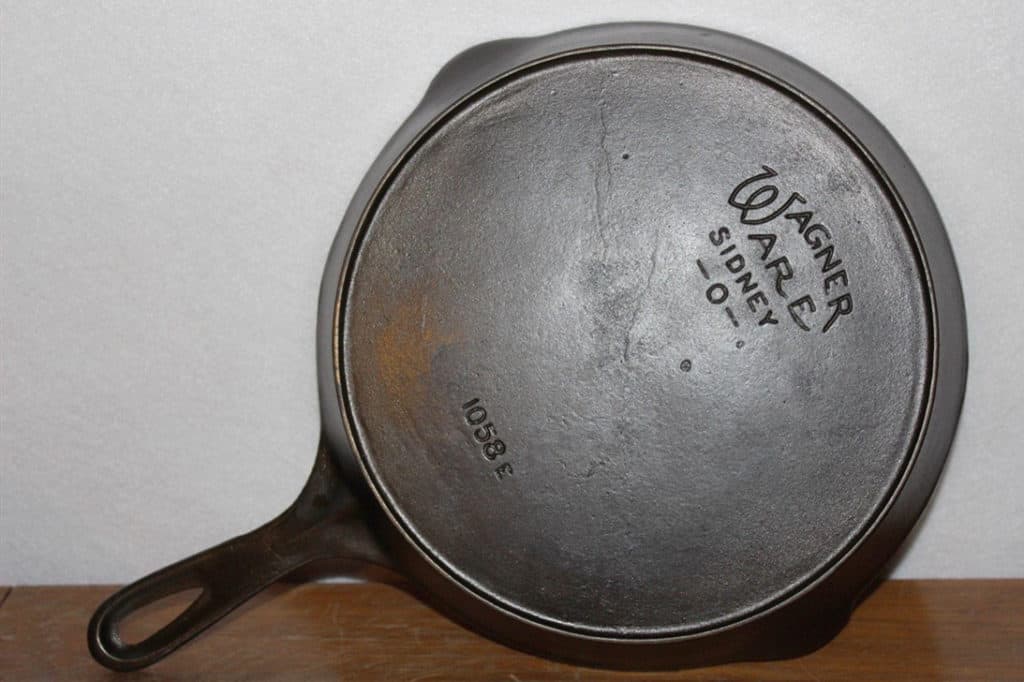Cast iron cookware can be some of the most inexpensive tools you can buy for your kitchen, especially when you consider their long lifetime of 150 years and beyond. You can find new cast iron skillets for as little as $40 per piece which makes them an excellent investment for the future.
Before we go into details, we have to warn you that vintage cast iron is so valuable that there are a lot of fake ones in the market. Take this quiz to find out if your cast iron pan is real or not:

The number on the handle
This number refers to a measurement of the diameter (length) across the bottom of the pan, but the stamped number does not signify the exact diameter in inches. A 10 on the handle doesnt mean it is a 10-inch pan. This goes completely against modern sizing standards. Skillets today are sold by diameter across the top – 10-inch, 12-inch, and so on.
There is a reason for the stamped numbers that do refer to size, but by much different measurements. Originally, cast iron was made to fit wood stoves that were commonly used for cooking in the 1800s and 1900s. There was an opening at the top that the cast iron pan sat upon, so the number was an indicator of compatibility between the pan and the type of stove it could be used with. These pans were often made by the same company that made the stove, and every company had a slightly different system.
Here is the traditional number system from a Wagner catalog, along with their corresponding size in inches:
Today, we dont use wood stoves and a cast iron skillet can fit on any stove, so the measurement standards have changed to indicate inches of diameter.
With antique cast iron, there are certain numbers that are very common and some that are very rare.
- Numbers #3, 6, and 8 are not considered collectible. They are still fantastic pans to use, but you wont be making a ton of cash off of these old cast iron skillets.
- The most desirable pan is #1 – theyre super rare and worth $1,000 each, despite their small size.
- #2, 11, 13, and 20 are not as rare as #1 but rare enough to be quite valuable. If you see one at a low price, snag it.
Sometimes an old cast iron skillet may have numbers accompanied by letters as well. Theyre referred to as “pattern letters”. Manufacturers would create a number 3 mold for example. But due to demand, they needed to have more than one mold in use at once.
They then used letters to differentiate between these identical mold patterns. A “3B” pattern would end up slightly different from “3C”, for example, because the identical molds would wear differently with use and eventually become less identical.
The letter is a way to differentiate and identify exactly which mold the pan was cast from.
How can you identify your cast iron?
The best way to quickly narrow down your cast iron cookwares origins is by checking the bottom for the insignia from a manufacturer. Some of the most popular and quality vintage cast iron makers of the last two centuries were as follows:
- Griswold Manufacturing
- The Vollrath Company
- Wagner Ware
- Favourite
- Atlanta Stove Works
- Wapak
These companies were founded in the late 1800s and early 1900s by blue-collar Americans throughout middle America (Pennsylvania, Ohio, Wisconsin), providing families with high quality cast iron cookware that lasts.
The Griswold name is well-renowned as the cream of the crop when it comes to vintage cast iron. They were especially well-crafted and the manufacturer paid extra attention to detail.
You must pay attention to the sizes and shapes of logos and properly research the particular one youre dealing with. These logos often changed throughout the years and are a great indicator of the age of the cast iron. For example, there are two Griswold logos – a newer one that is about 2 inches wide, and an older logo which is much larger at 4 inches wide. The new pans with the small logo dont have any real collectible value yet while the old logo pans can fetch a pretty penny.
Wagner Cast Iron Skillet Logos
FAQ
How do I know if my cast iron is valuable?
Is Wagner cast iron collectible?
Can I sell my cast iron?
Is Wagner cast iron still made?
What is Wagner cast iron?
Wagner cast iron is antique cookware that is regarded as one of the best in the market. Despite its age, it still works fine. It is bought by people who prefer vintage cast iron cookware or collectible enthusiasts. However, it can be challenging to identify Wagner cast iron. Below is the cookware’s history and how to identify it.
What determines the value of Wagner cast iron?
Here are some of the things that determine the value of Wagner cast iron: The construction often determines how old the cookware is and how much it is worth. Usually, vintage cookware like Wagner cast iron often has raised rings at the bottom, allowing some space between the cookware and the stovetop.
Is Wagner Ware a good brand?
The Wagner Ware brand included a wide assortment of cast iron kitchen products, and was known for producing extremely high quality, yet affordable, cast iron. Wagner Ware’s line of superior cast iron included dutch ovens, muffin pans, waffle irons and even griddles.
Are Wagner cast iron pans collectable?
Wagner cast iron pans are collectables. The Wagner Manufacturing company began making cookware in 1891 in Sidney, Ohio. Today, collectors prize Wagner cast iron frying pans, Dutch ovens and bakeware for both its beauty and durability. You can find Wagner cookware at garage and estate sales, thrift stores, antique stores and from online dealers.
